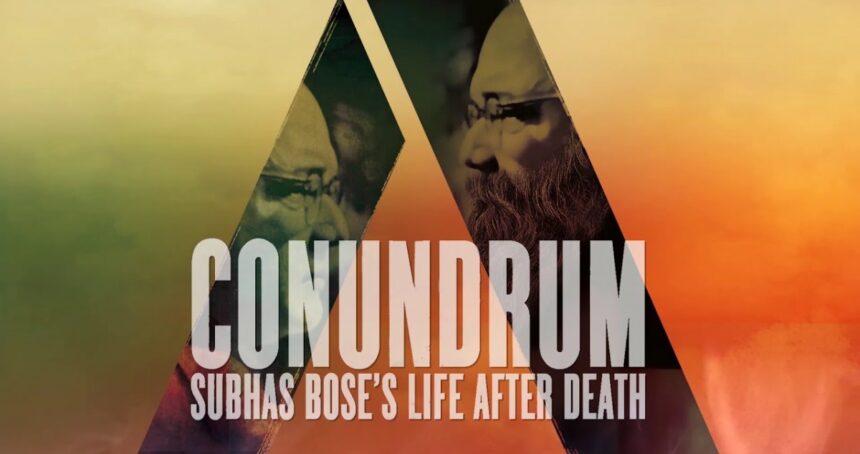The man, the myth whose life story has never been fully revealed or understood.
Conundrum: Subhas Bose’s Life After Death

The much-awaited book “Conundrum: Subhas Bose’s Life After Death” by Anuj Dhar and Chandrachur Ghose contains 15 years of painstaking research done around the mystery surrounding one of India’s greatest freedom fighters and mass leaders. The official position of successive governments is that Bose passed away in an airplane crash, however, the book explores two more possibilities concerning his survival after the alleged crash. The book looks at the theory of Netaji as a mystic baba in U.P called “Bhagwanji” or as the press liked to call “Gumnaami Baba”. Both authors explore the third theory behind Netaji’s disappearance in their painstaking quest to find answers as they went through numerous interviews, personal accounts, declassified documents, etc. The book packs a lot of mystery behind this figure. as someone who seemingly had access to the leadership in China, Russia, etc. A person who would fondly talk about Mao, vehemently oppose Nehru and have a lukewarm relationship with Gandhi, Bhagwanji seemed to be in all aspects someone either close to Bose or Bose himself. His handwriting was analysed to be similar to the late leader. His usage of the language, as many witnesses claim, bore a strikingly uncanny resemblance to the way Bose used to deliver his speeches. The book dives into many spheres of life and one might say that, given how unique Netaji was, this was indeed suited and crafted in that sense. Nevertheless, the book retains its mystery and tries to highlight how successive governments shied away from launching an actual probe into the account of Netaji Bose after the airplane crash.
The book starts with the death of the Baba in the 1980s, that’s where the whispers start coming. The authors have deliberately made such a narrative to pick and choose from the past and the present, for piquing the interest of the reader. To be honest, since it’s a book based on a lot of research, the chapters have the potential to get very long and tiring at times. A whole chapter dedicated to the report on Bhagwan Ji’s handwriting itself shows certain nuances that may or may not be interesting for every reader. The two authors could have achieved more had they wished of making a series based on their research, rather than presenting it in one book. But, one can probably understand why the authors chose to adopt this method of story-telling.
Nevertheless, the story has interesting and captivating moments as well. The authors showed a great deal of interest and spheres where Bhagwanji was interested. The Baba is rumoured to have had a keen interest in other aspects like geopolitics, internal politics, and religion. The authors have recorded some instances when the Baba has claimed to have intervened in the Sino-India conflict, as well as helping the Dalai Lama escape. The authors somehow find one reference for this but such difficult and sketchy aspects need more investigation and research. It’s quite frankly an adventure that helps the story keep the interest piqued till the last page. The authors also address criticisms of their rivals, most notably from some prominent members of the Bose family. The book addresses the work done by the authors of the book “The Prisoner Of Yakutsk” and concludes on the basis that while it is slightly easy to copy characteristics and mannerisms, it is however impossible to completely mirror someone’s handwriting. Therefore, both Chandrachur Ghose and Anuj Dhar state that Bhagwanji was indeed Netaji Subhas Chandra Bose.
The book is a lengthy read, almost as a research paper is made in any particular stream. It has many layers of patterns that need to be further looked and researched to bring a close to the chapter of Bhagwan Ji and Bose as well. The fact that governments have shown a lack of approach addressing this properly is repeatedly highlighted. The book tries to keep the element of truth alive for Netaji and his legacy. Despite repeated accusations thrown at the authors, they have managed to knit web of untangled and interesting aspects that keep the book pacy, but at times too complicated to read. That is not a fault with the story or the research but like I earlier mentioned, it would have helped if the wealth of information could have been divided into either two or three parts. Perhaps the authors felt it’s necessary that such a particular story has many nuances that are interlinked and slightly complicated to be left alone in a different book. At the same time, it is interesting for those who truly show interest in this mystery as the attention given to every particular finding has its moments of crispness and even blandness since the authors try to avoid getting trapped into any particular loose end. It is very fascinating to see how they have managed to travel widely and picked up every little source which they can about Netaji. From Russia, Vietnam, China to even declassified documents of the CIA, the book does show a lot of work done by both authors purely in their aspect of finding the truth.
Therefore, “Conundrum: Subhas Bose’s life after death” is a must-read for people who admire investigative journalism and adore Netaji. It’s not, however, a book for every average reader who has a habit of skimming through and trying to understand in bits and pieces.

Leave a Reply